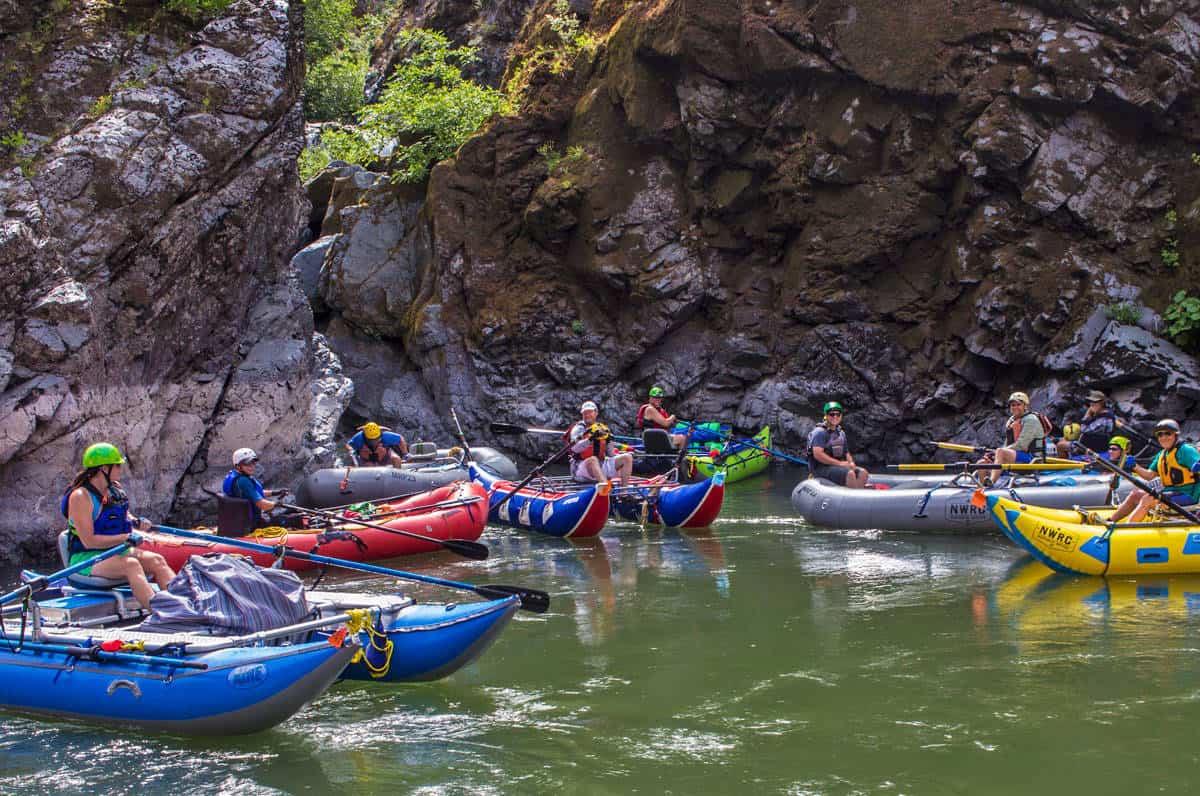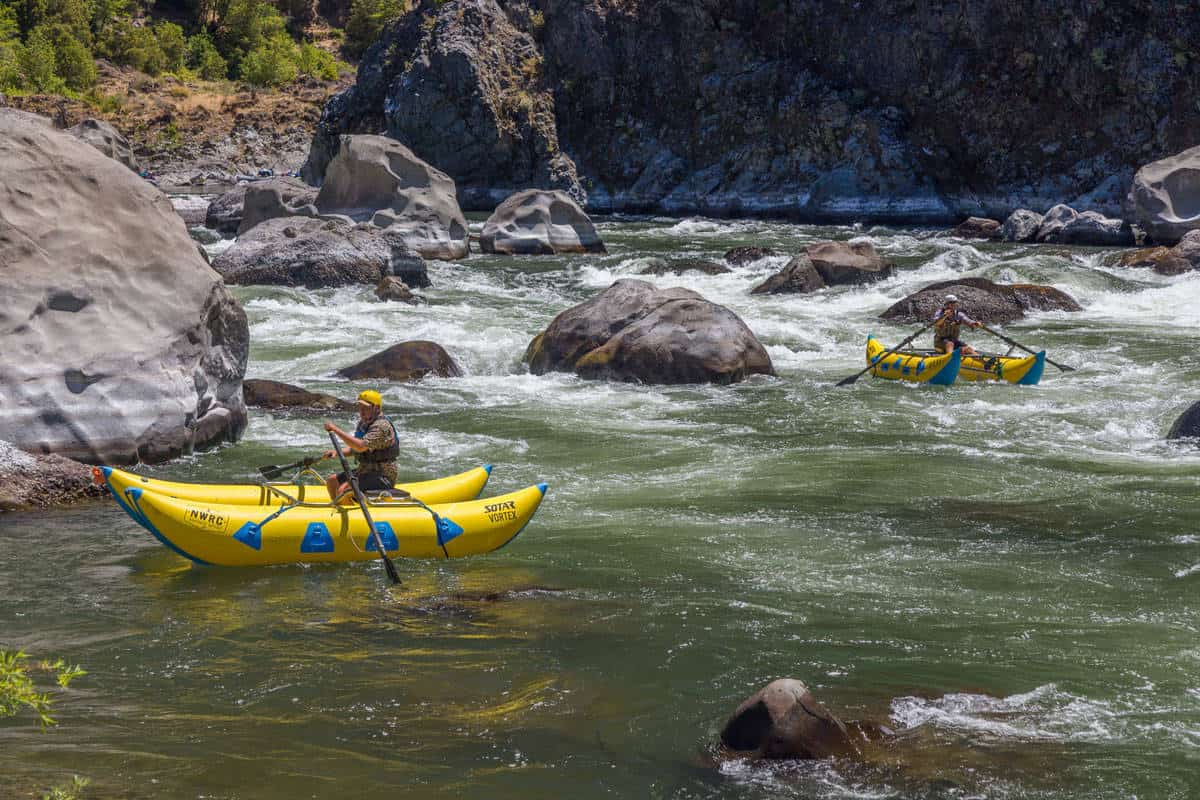On the last day of the June 1, 2016 Rowing School, Tamie Stonke, one of our students, came up to me and exclaimed, “I have been rowing for 14 years, how come no one has ever taught me this stuff?”
This is the third year I have been fortunate to be an instructor in the Northwest Rafting Company Class III Rowing School. Three years ago my wife Susan and I were talking to Zach Collier the owner of Northwest Rafting Company in his Hood River office. We had been leading yoga rafting trips with Zach for many years. Somehow the conversation turned to my dream of a rowing school where every student would row their own boat.
Zach said, “we are already doing that trip.”
“Everyone in their own raft?”
“Yes, it begins on June 3rd, do you want to be an instructor?
“Yes!”
“OK, you’re on it.”
That was 2014 and it would be my first experience of teaching rowing on a 5 day trip down the Wild and Scenic section of the Rogue River. For beginner and intermediate rowing students this stretch of river is nearly perfect. Zach’s plan of putting every person in their own boat was as good as I had hoped it would be.

Whitewater rowing has two fundamental components – oar skills and reading the river. With basic rowing skills you can read the water with basic proficiency. Once your rowing skills improve, your water reading can become more sophisticated. With more sophisticated water reading, you can add the next levels of rowing skills. The two aspects move forward in lockstep.
The Rogue is laid out beautifully for letting the two skill sets build upon each other.
This allowed for working with rowers of many different skill levels. There was always a next step that could help each student progress. It was fun to watch.
From the June 1st 2016 session student Mike Roach said, “So many people from so many different backgrounds and starting on so many different levels all came together in the end.”
Dave Baker was on the June 7th 2016 rowing school. He put it this way, “I can only imagine the challenge facing the instructors having a diverse group with various levels of experience, confidence, and ability. You were able to pull it off in a way that beginners did not feel in over their heads and more experienced rowers were able to focus on more advanced skills.”
It was actually a lot of fun for the instructors. Once students found the rowing skill to get their heads up and look at the water, they could begin to understand it better and better. With each new understanding, they were ready for a new piece of skill to utilize what they saw.

There is an old expression. You can give a man a fish and he can eat or you can teach a man to fish and he can eat for the rest of his life.
Again to quote Dave Baker, “The progression of the…curriculum allowed us to build confidence to the point where we could read and run class 3 rapids independently and safely without simply following a guide through the best line.”
Dave came into the class with some rowing experience, but even students with no previous experience ended up with opportunities to enter and read rapids on their own, and they did well, some extraordinarily well.
Along the way, we witnessed lots of revelations. Light bulbs came on for everyone as the days progressed. These were the points where students began putting things together for themselves. The once chaotic environment of a rapid began turning into something they could understand.
Again to quote Tamie, “I have been battling with eddies for all these years and now eddies are my friends.”
Discovering how eddies could actually help her navigate rapids, transformed her understanding. Utilizing eddies is just one example of how learning to work with the water gave students whole new levels of control and confidence.
“I have been battling with eddies for all these years and now eddies are my friends.”
– Tamie Stonke
By the middle of Blossom Bar on day 4, all the students had the chance to negotiate a tricky series of moves that add up to Class IV complexity. Student Paul Wagner found that out in the boulders and fast water he no longer felt anxious. He just made one move at a time, reading the water and using his technique to get the proper angles and do the things he had learned. Because he was working with the water and not fighting it, he felt calm and confident making his way all the way from river right to river left through the bottom two thirds of Blossom Bar.
There is always more to learn. Some students came to the school with the goal of rowing private trips through the Grand Canyon and wrote about it afterward.
“… I made it down the Grand Canyon last summer …I made it through Crystal and Lava (and all the others) and enjoyed the rush. I even thought of you on a few of the rapids remembering what you said about how to approach … a long bend in the river.” -Marc Schwartz
“The coaching tips were immensely helpful on the Grand Canyon. I am so proud of myself I rowed all of the major rapids and didn’t flip my boat. Thank you.” -Ryan Kirkpatrick
Others came to learn how to take their families down the Rogue River. Or just to have fun on the water. Five days on the Rogue gave them a foundation. The rest of learning to row is something that they can now do on their own. A river puts in the same honest day’s work every day and to be a good white water rower, we all have to show up every day with the same honesty and respect. Giving everybody their own boat for five days on the Rogue River is helping people be better and safer rowers. Thank you Zach.

